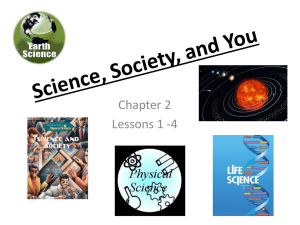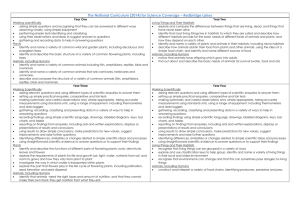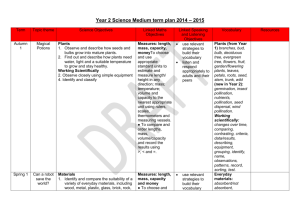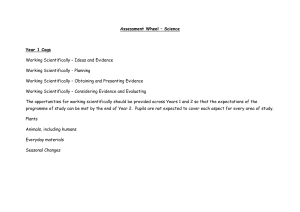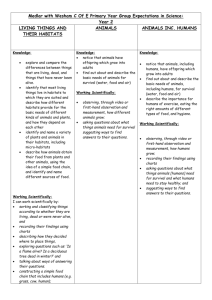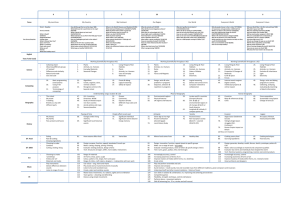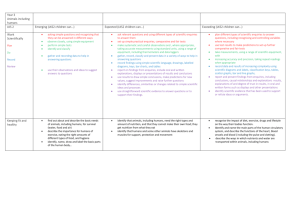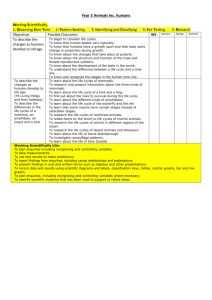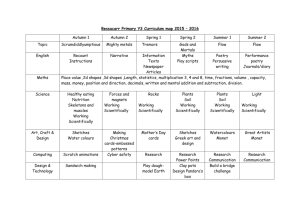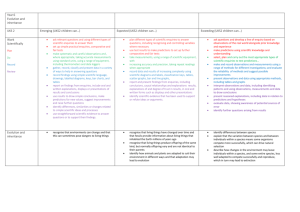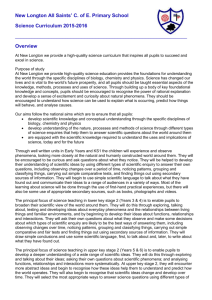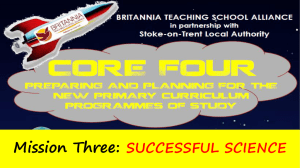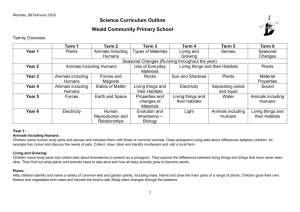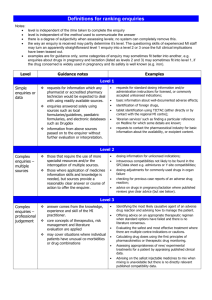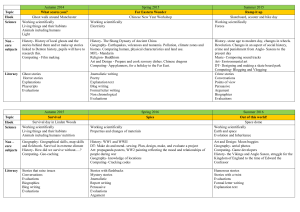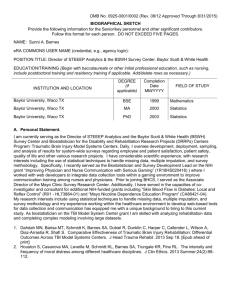assessment_wheel_year6
advertisement
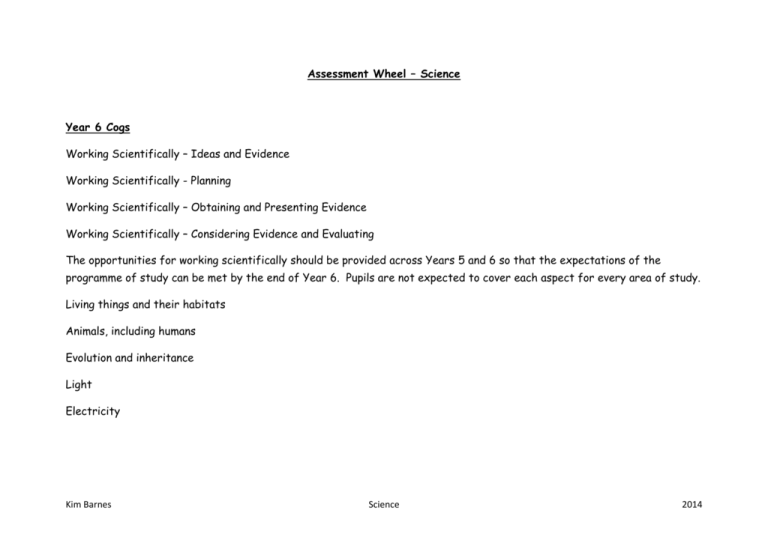
Assessment Wheel – Science Year 6 Cogs Working Scientifically – Ideas and Evidence Working Scientifically - Planning Working Scientifically – Obtaining and Presenting Evidence Working Scientifically – Considering Evidence and Evaluating The opportunities for working scientifically should be provided across Years 5 and 6 so that the expectations of the programme of study can be met by the end of Year 6. Pupils are not expected to cover each aspect for every area of study. Living things and their habitats Animals, including humans Evolution and inheritance Light Electricity Kim Barnes Science 2014 YEAR 6 Working Scientifica lly Ideas and evidence W S Planning Experimen tal Work I can ask simple questions and recognising that they can be answered in different ways. I can identify and classify. I can perform simple tests using simple equipment, observing closely. W S Obtaining and Presenting Evidence I can gather and record data to help in answering questions. W S Considerin g Evidence and Evaluating I can use my observations and ideas to suggest answers to questions Kim Barnes I can ask relevant questions and using different types of scientific enquiries to answer them. I can set up simple practical enquiries, comparative and fair tests making accurate and careful observations. I can gather, record, classify and present data in a variety of ways to help in answering questions. I can use simple models to describe scientific ideas.. I can record findings using simple scientific language, drawings, labelled diagrams, keys, bar charts, and tables I can take measurements, using a range of scientific equipment, with increasing accuracy and precision. I can use results to draw simple conclusions and suggest improvements I can suggest new questions and predictions for new values in my results. I can identify differences, similarities or changes using my knowledge of scientific ideas and processes. I can use straightforward scientific evidence to answer questions or to support their findings I can take accurate measurements using standard unit. Science I can use test results to make predictions to set up further comparative and fair tests I can use a range of equipment, for example thermometers and data loggers. I can plan different types of scientific enquiries to answer questions. I can record data and results of increasing complexity using scientific diagrams and labels, classification keys, tables, bar and line graphs. I can report and present findings from enquiries, including conclusions, causal relationships and explanation of results, in oral and written forms such as displays and other presentations. I recognise and control variables where necessary. I can identify scientific evidence that has been used to support or refute ideas or arguments. 2014 Living things and their habitats I am able to group a wide selection of different animals into groups according to their characteristics. Animals including Humans I can identify and name the main parts of the human circulatory system. I understand that when I exercise my heart beats faster to take blood more rapidly to the muscles that need it. Evolution and inheritance I can my knowledge of skeletons and the evidence of fossils to develop my understanding of how living things have evolved over millions of years. Kim Barnes I can use the terms, vertebrate, fish, amphibian, bird, mammal, reptile, invertebrate, insects, arachnids, worms, flowering and non- flowering, when grouping living things. I can make careful, repeated measurements of pulse rates and record my findings in a graph. I can explain what my graph shows and use the patterns to draw conclusions. I can use classification keys to group living things and give reasons for my choices. I can use a branching database to identify an unknown plant or animal. I can research the work of scientists such as Carl Linnaeus to find out how they developed classification keys. I can explain what the effect of diet and exercise are on our health. I can list ways of making healthy lifestyle choices. I can give examples of harmful and helpful effects of drugs on our body. I can investigate the role of blood in our body as a transporter of nutrients and oxygen around the body. I can find out how other animals transport water and nutrients around their bodies. I know that living things produce offspring of the same kind but are not usually identical to their parents. I can investigate how some plants have adaptations that allow them to live in a particular habitat. I can describe how animals from different habitats are suited to their habitats. I can describe how, over time, some animals have developed special features that allow them to survive in their habitat. I can research the lives of Charles Darwin, Mary Anning and Alfred Wallace, looking at how they developed their ideas on evolution. Science I can research the work of scientists such as Jenner and Pasteur, finding out how their discoveries improved people’s health. 2014 Light I can investigate how light behaves using reflections and shadows. I can explain patterns in my results. Electricity I can investigate what happens to a buzzer or bulb when I change the number of cells in a circuit. Kim Barnes I understand that light travels from a source and know that light sources are seen when light from them enters the eyes I can predict what will happen when I add different components to a circuit. I can draw diagrams with lines and arrows to show how we see things when light is reflected from them. I can explain the difference between the shadows and reflection in terms of the path of light. I can draw and label an electrical circuit diagram using recognised symbols. Science 2014
